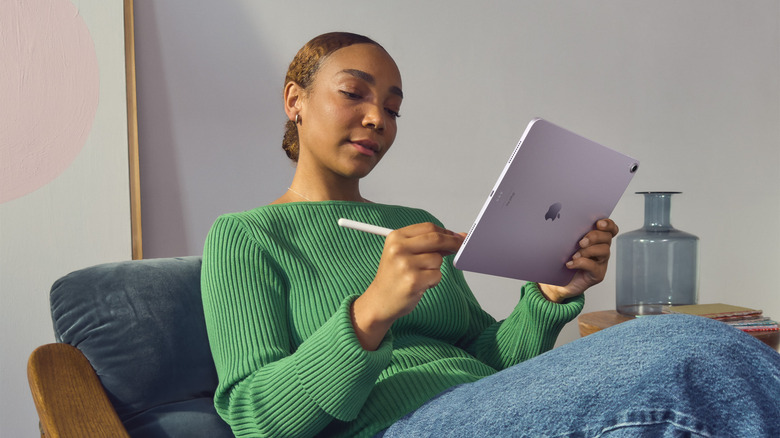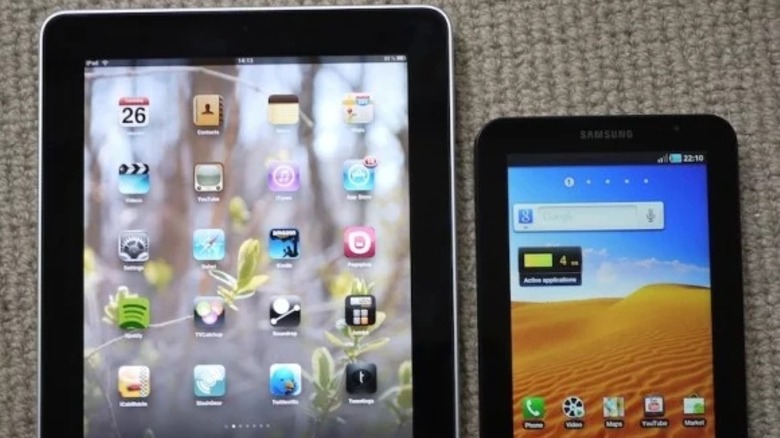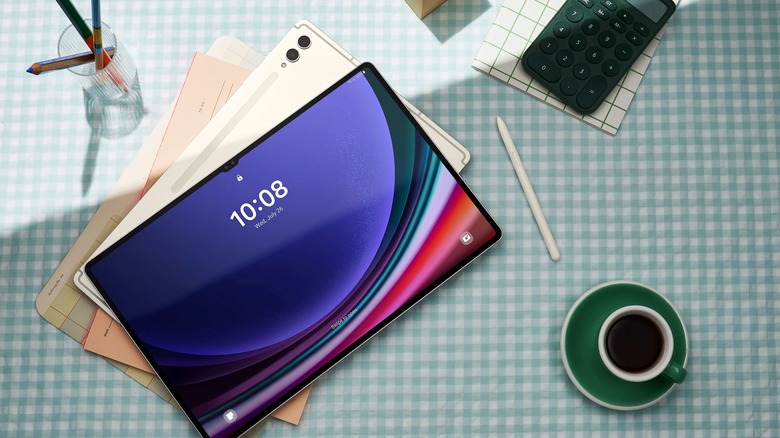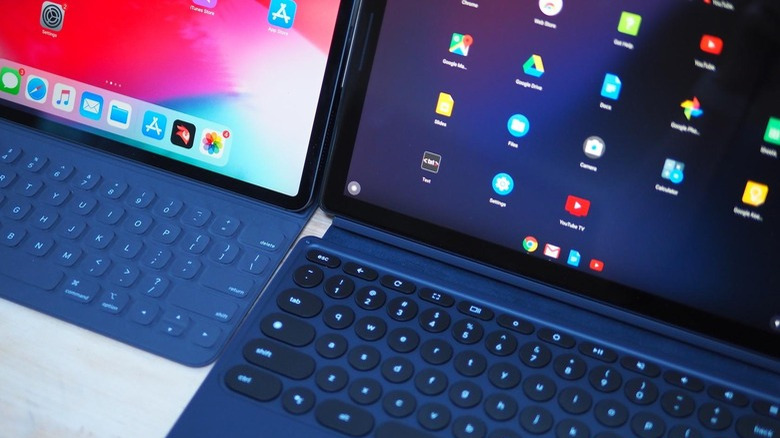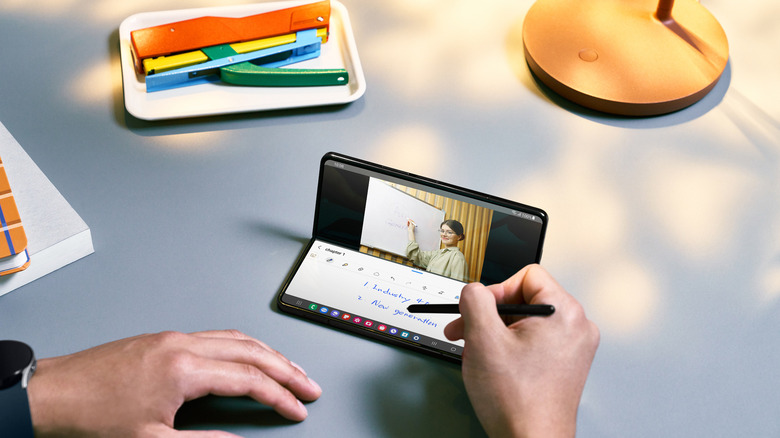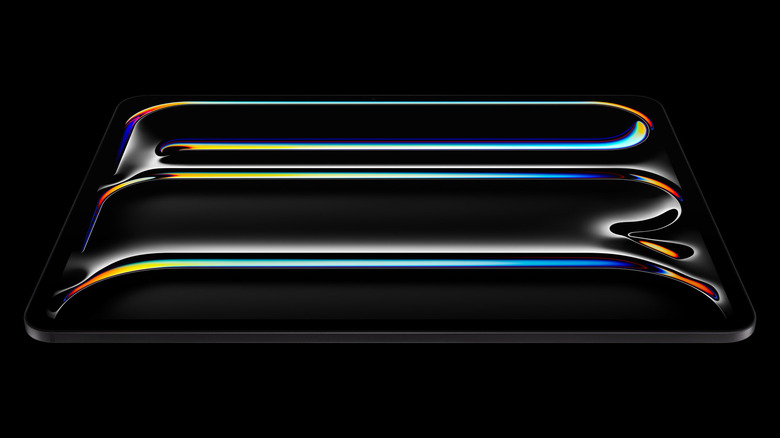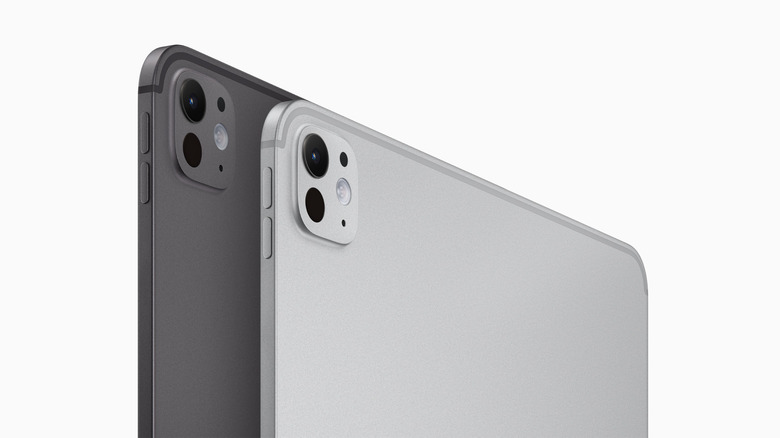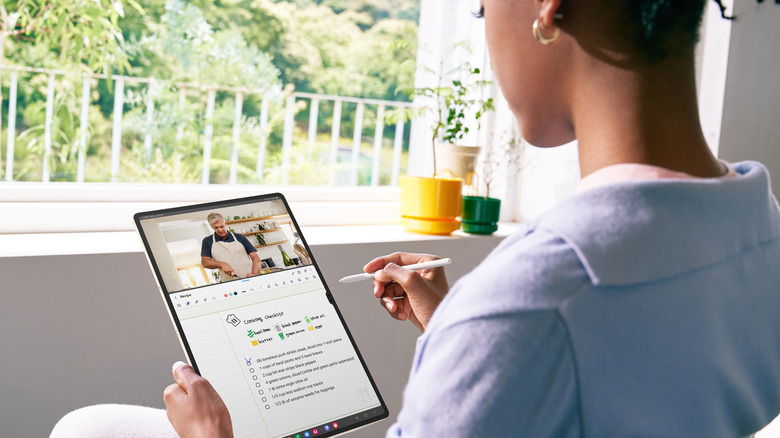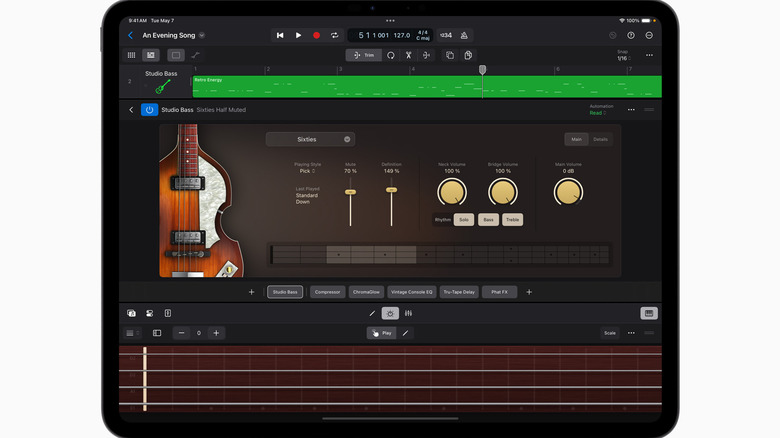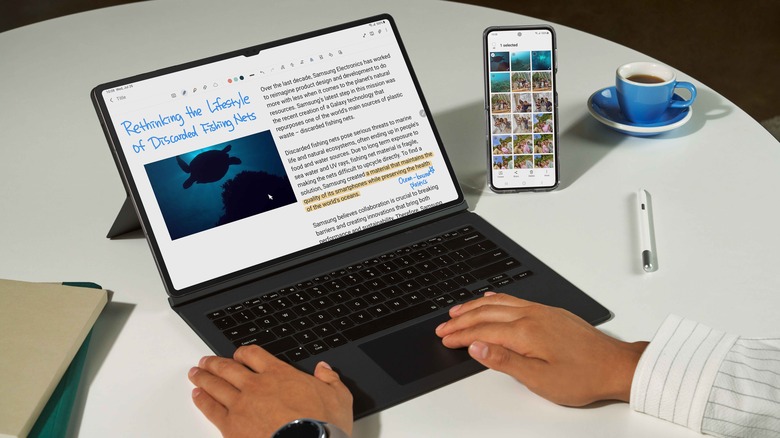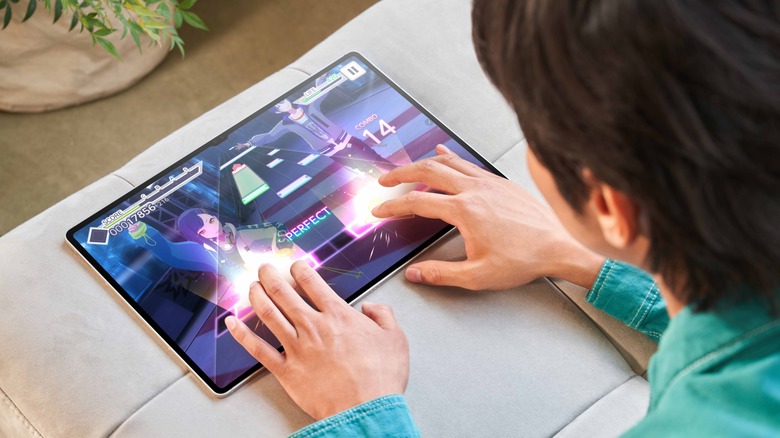9 Reasons Android Tablets Never Beat The iPad
Apple and Google both updated their tablet lineups in May 2024, but unless you're the sort of person who combs through every bit of tech news, you probably only heard about the new iPad Pro and iPad Air. Android tablets remain on life support, carried forward only by Samsung and a few other torchbearers. Even Google doesn't seem that invested in keeping the product category alive. Its new Pixel Tablet is a $400 midrange device with an outdated processor. Meanwhile, the new iPad Pro has a bleeding-edge tandem OLED display and carries the M4 chip that outclasses the latest MacBooks. In other words, while Apple continues to push the boundaries of what a tablet can do, Google seems to have given up on making similar strides with Android tablets. Even the term "Android tablet" evokes a lack of quality in some people.
Of course, it's true that high-end Android tablets do exist. Samsung's Tab S9 series are absolute powerhouses that even beat out the iPad Pro in a few key areas like multitasking. But whereas Android phones are getting better each year and outselling the iPhone worldwide, the same cannot be said for tablets. The iPad is, at this point, so dominant that even those who would never purchase an iPhone know that the iPad is the only real tablet game in town. To put that in numbers, Statcounter says as of 2024 Apple owns over 57% of tablet sales in the U.S., Samsung just over 16%, and other brands barely register. So, how did this happen? How did Google allow itself to be lapped by Apple in this product category, and what would need to happen for Android tablets to finally stand a chance against the iPad?
Google was late to market
Early in its lifespan, Android wasn't running on any tablets. The product category was considered a failed experiment dotted with failures like the Apple Newton until Apple revived it for good with the original iPad in 2010. Few at the time saw the emergence of tablets on the horizon, even as smartphones were in the process of changing our lives. The original Galaxy Tab, a lackluster device that was a clear response to the original iPad, arrived late in 2010 running Android Froyo and was later updated to Gingerbread, which wasn't well optimized for the form factor. Other monstrosities such as the media-forward Android Internet Tablet from Archos launched to muted reception.
Android 3.0 Honeycomb was Google's first attempt at moving its OS into the tablet space. But although it brought a lot more functionality than iOS had on iPad at the time — including a fully-fledged task switcher and modern, onscreen navigation buttons — it failed to turn the tide. Its launch devices, such as the heavily advertised Motorola Xoom (check out our review), weren't bad devices, but they were lackluster and couldn't compete with Apple's early market advantage, especially as Apple's hype bubble was expanding at supersonic speed in that era. At the time, there was also some small but not unimportant competition from Palm/WebOS, making it even harder for Android tablets to pierce through the noise. And within two years of the original iPad, Microsoft joined the fray, launching its Surface lineup in 2012. By the time Google launched the Nexus 7 the same year, the success of the smaller slate was far from enough to put Android tablets ahead of the iPad.
Only Samsung has been consistent
The first Android tablets, such as the Galaxy Tab and Motorola Xoom, were all over the map without Google to unify a clear vision. The company finally threw down the gauntlet with its own Nexus 7 and Nexus 10 devices, and even saw some mainstream success with the former. But the search giant apparently found it hard to commit to the tablet market and didn't press its advantage in the small tablet space it had carved out. Meanwhile, the only company consistently producing high-end Android tablets and innovating in that space is Samsung. The first Android tablet was the original Galaxy Tab, and it's the longest-running Android tablet line, with new Tab models released to this day. They have extremely impressive hardware, but Samsung feels like a lonely island in the sector.
To understand how Android tablets fell so far behind the iPad, all we really need to do is look at Google's lineup. At the moment, it consists of the Pixel Tablet, a midrange device with a 1,600 x 2,560 pixel display and Tensor G2 chip, which is outdated next to the Tensor G3 in the Pixel 8 series of phones. Its hallmark feature is that it can function as a Chromecast receiver — yes, the same receivers you can find for around $30 at your local Walmart. Buy a dock for it, and it will also function as a Google Home hub. Those are nifty features to be sure, but is this really a device Google thinks will be competitive against the iPad? At $400, or $500 with the dock, the Pixel Tablet can't even undercut the iPad in price now that the entry level iPad costs only $350.
Google doesn't know what it wants a tablet to be
Here are the tablets Google has released over the years in chronological order:
- 2012 — The Nexus 7 and 10, two great devices named on the basis of their respective screen sizes, with the former being a pretty big hit.
- 2013 — The second-generation Nexus 7, a modest but respectable sequel.
- 2014 — The Nexus 9, a very pretty tablet built by HTC back when it was building very pretty devices like the M8 smartphone.
- 2015 — The Pixel C, which, yeah, it sure was a tablet that ran Android.
- 2016 — Nothing.
- 2017 — Nothing.
- 2018 — The Pixel Slate, a tablet that ran on Chrome OS. Clearly there were some internal battles going on inside Mountain View.
- 2019 — Nothing.
- 2020 — Nothing.
- 2021 — Nothing.
- 2022 — Nothing.
- 2023 — The Pixel Tablet, a mid-range tablet with a dock that doubles as a Nest Hub. It was perfectly mid, as in, it was just fine.
- 2024 — The same Pixel Tablet, this time with the dock made optional.
There's not much more to say. Pick a lane, Google. The company seems to lack the focus to make a single tablet line and iterate on it like it's done with the Pixel phones. Or maybe Google just doesn't have the desire to compete with the iPad. Now, maybe there aren't enough people clamoring for better Android tablets to make them a bigger priority for the business. Unlike Apple, which is primarily a hardware company, Google's focus is software. It's entirely likely that it's content letting hardware partners like Samsung chart the future of Android tablets. It feels as though Apple is charting a bold path for the devices as the future of computing while Android's models remain awkwardly large smartphones. Which brings us to another part of the conversation: form factor.
Android has other form factors to consider
One often-ignored difference between iOS/iPadOS and Android is that Apple only makes slab-style phones and big, slab-style tablets. Meanwhile, Android comes in all kinds of shapes and sizes — foldables, flippables, bendables, scrollables, and tigers, oh my! Today, large foldables like the Pixel Fold and Galaxy Z Fold5 blur the lines between phone and small tablet, occupying the same niche as small tablets like the Nexus 7 once did. Even in the early days of Android, phablets arrived to fill the gap between the two mobile devices. Because there are so many options, tablets are less of a glaring gap in Android's resume.
Instead of pursuing tablets as a "third device" like Apple has done by inserting the iPad as a middle ground between the iPhone and MacBook, Google has focused on making Android scalable to screens of any size so that hardware manufacturers can implement it in any form factor of their choosing. It's up to the free market to decide on the form factor the operating system lands in, and so far, the market has mostly said "No thanks" to tablets. Again, it's worth noting Samsung as a major exception, but perhaps there's not room for any further competition against the twin Goliaths of Apple and Samsung.
iPads are getting more powerful, Android tablets aren't
As Android evolves across various form factors, the difference between the iPad and even the most high-end Android tablets is becoming a gulf too wide to bridge. In 2024, Apple just put the M4 chip, its latest, desktop-grade, custom silicon chip into the iPad pro. The same year, Google equipped its Pixel Tablet with the Tensor G2 that powered many of its early-2023 devices. Now, that's a low-end tablet, but even at the high end, the Samsung Galaxy Tab S9 Ultra is equipped with a Snapdragon 8 Gen 2. That's a remarkably good smartphone chip, but it's not in the same league as the desktop-grade M4. If you want a computer-grade tablet that isn't made by Apple, you'll need to look at Windows devices.
In terms of software, the gap is a little bit closer than spec sheets suggest. Android remains much more feature-rich than iPadOS, especially when companies like Samsung apply their custom skins. This article was written mostly on an aforementioned Galaxy Tab S9 Ultra, a workflow only possible because of Samsung DeX, which runs a desktop environment natively on the tablet's laptop-sized OLED display. With the ability to truly multitask, Samsung's option is a much more suitable replacement for a laptop than Apple's latest, M4-equipped iPad Pro.
So, if Android is that much more capable, not to mention the dominant OS globally, why do tablets that run it fail to stand against the almighty iPad? Well, it comes down to feedback loops.
Positive iPadOS feedback loops
Back in the day, Bill Gates was known to ask what the "killer app" for a particular platform would be. If he could identify a must-have program, he knew Microsoft's competition. But when it comes to the iPad, there's not just one killer app — there's a whole store full of them. It's common knowledge that iPad apps are incredibly robust compared to their Android tablet counterparts, and that remains the case, which only reinforces the iPad's market dominance.
The more consumers buy iPads, the more incentive developers have to prefer iPadOS over Android. This ensures that the app gap never closes because Android gets sloppy seconds — if it gets anything at all. Those tides are slowly turning, with programs like Goodnotes and LumaFusion that were once iPad exclusives now available on Android tablets. But by and large there are far more iPad apps that have no reason to jump to another platform.
Negative Android feedback loops
The fewer consumers buying Android tablets, the less incentive there is for original equipment manufacturers (OEMs) to roll the dice on making new ones. Only Samsung — which is clinging for dear life to 16% of the domestic tablet market while holding 26% of the global market — can afford to consistently produce a range of tablets. OnePlus is giving it a shot, with last the 2023 OnePlus Pad being a pretty great device that won an 8/10 in SlashGear's review of the product. But the implied conclusion was that the Pad more directly competes against Samsung's tablets than it does the iPad.
To understand why more Android tablets on the market can harm the companies that make them, we have to look at the journey a consumer goes on when choosing a tablet. The hierarchy of choice when buying a tablet is a) the decision between iPad and Android, followed by b) the choice of tablet within that preferred ecosystem. Anyone who chooses to buy an iPad is giving their money to Apple, whereas anyone who chooses to buy an Android tablet might give their money to one of a few different companies. That means each must compete with the others for that customer instead of competing as a collective against Apple. In other words, Android tablets fight among themselves for the market share Apple leaves behind, so returns diminish for each company that enters the market. For most hardware companies, it's a bad business decision to enter the Android tablet market.
The app ecosystem is a wide gap to close
Anyone who owns an Android tablet knows that the grass is greener in iPad OS' pastures. That's largely due to the lack of tablet-optimized apps in the Play Store. Again, this problem has been around since the early days of Android tablets and stems from the fragmentation of hardware running Google's operating system. Developers can make great apps that run across multiple models of iPad, whereas developing for a bunch of Android tablets from a variety of manufacturers with a range of different hardware is much more challenging. This is ostensibly one of the problems Google has been trying to solve by emphasizing app scalability.
There are currently more great tablet apps for Android than ever before, but not even close to as many as are in the App Store. Moreover, many of the apps that iPad users love most aren't available on Android at all. For example, the beloved illustration app Procreate has no Android version, nor does the celebrated Notability note-taking app. And it goes without saying that Apple hasn't bothered to develop Android versions of proprietary apps like Final Cut Pro or Logic Pro, which it uses as a selling point for iPads. (Apple Music is great on Android, but it's the exception.)
Clunky Android implementations
You might ask, "Who cares that iPad has more optimized apps and better specs? Android apps are scalable, so tablet optimized apps are just overkill anyway." But that line of thinking forgets that scaled up phone apps often feel weird and empty on a large display. Frankly, Google doesn't make tablet development appealing to third-parties when even some of its own apps aren't optimized for tablets. YouTube Music is a stretched out phone app, as are Google Tasks, Google TV, and the Google app itself.
There are, to be fair, a growing number of well-optimized Android tablet apps, and more options that were once iPad exclusive are making their way across the aisle. But even so, they often feel lackluster in comparison. For instance, LumaFusion — the powerful video editing app that was once iPad-only — is now on Android, but some say it just isn't as smooth an experience.
In fairness, there are some apps that are far better on Android tablets. For example, Instagram has a tablet-optimized layout now whereas its iPad counterpart does not. But overall, you can simply expect iPad apps to feel more bespoke. Because tablets are app-centric devices, that's a massive hurdle that Android has never fully overcome.
It's not all bad news for team green
All hope is not lost for Android tablets. While it doesn't look like they'll have a renaissance anytime soon, they're a more mature product category than ever before. Manufacturers like Samsung, left to innovate alone, have pushed Android in new directions. The latest Galaxy Tabs have software capabilities which, despite the iPad's incredibly powerful internals, have never shipped on iPadOS. And while some of the iPad's best apps remain unavailable for Android, more apps arrive all the time.
It's already the case that, despite having decidedly less powerful processors, Samsung's tablets have a more mature, desktop-like multitasking experience in DeX for tablets than Apple has been willing to give its incredibly overpowered iPad Pro lineup. On that basis alone, there's a path forward for Android, especially if future tablets can be equipped with the next generation of ARM processors. And the tablet-optimized apps that work well on Android are plentiful, even if they can't match the iPad's selection. Video streaming, document editing, and other common tasks are a fantastic experience. We haven't touched on it elsewhere in this article, but gaming, too, is better on Android since it lacks Apple's restrictive policies. You can't play "Fortnite" in a native iPad app, and there aren't apps for game streamers like Xbox Game Pass or Nvidia GeForce Now on Apple's hardware, either.
So, it's fine that Android tablets will never be iPads. Android may appear at a surface level to be a direct competitor, but it's a different beast altogether. Whereas Apple has always offered a singular, take it or leave it vision for the products it makes, Android is raw claw to be molded in the hands of many different entities. That's a valuable quality not to be taken for granted.
